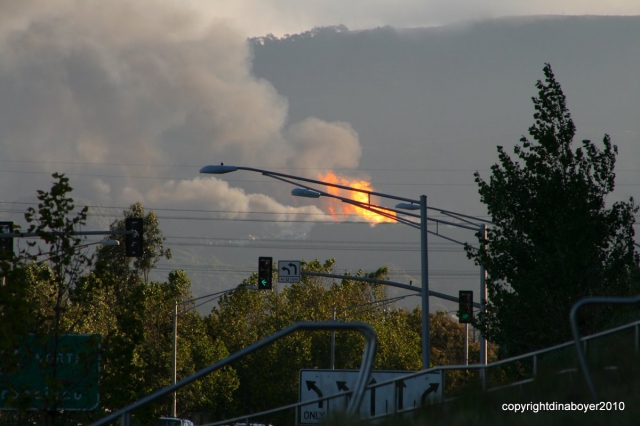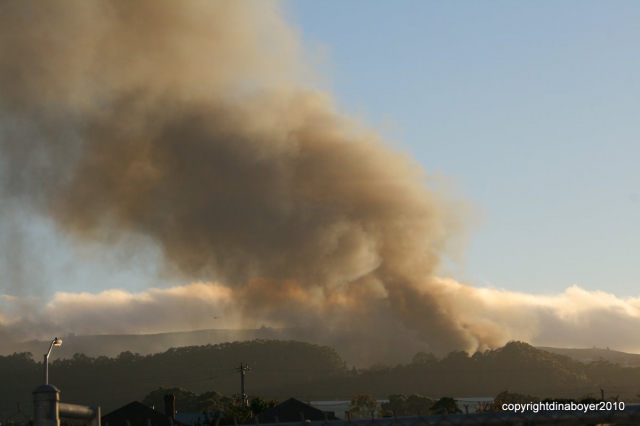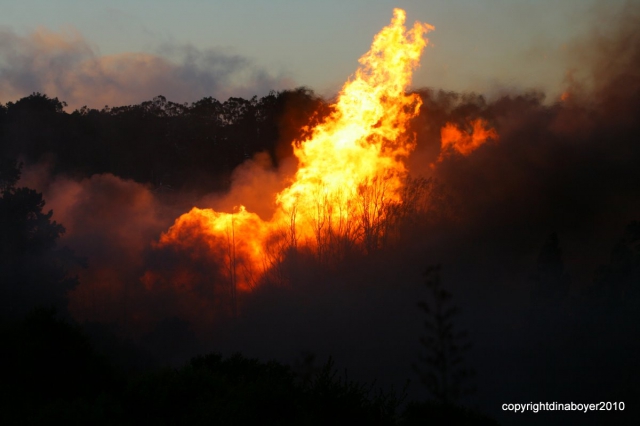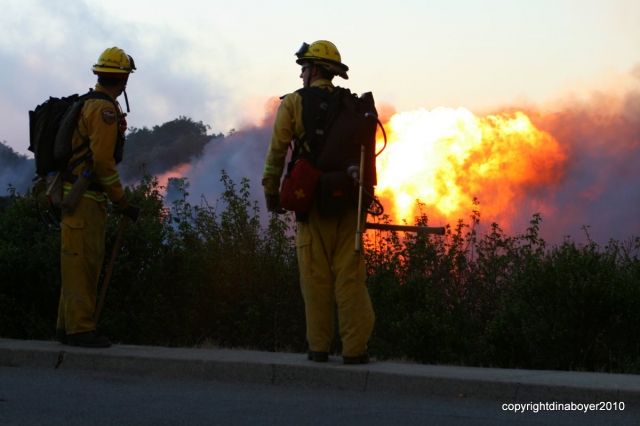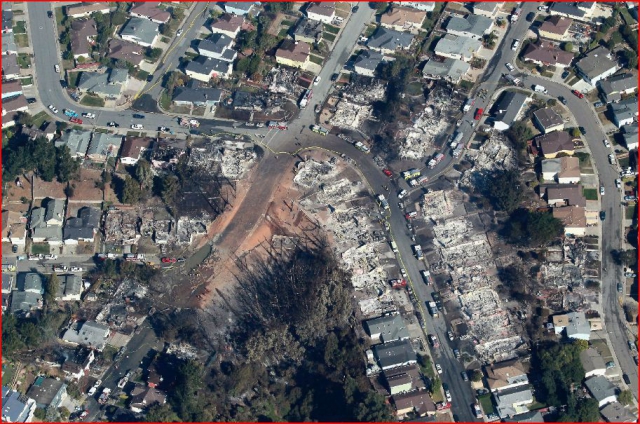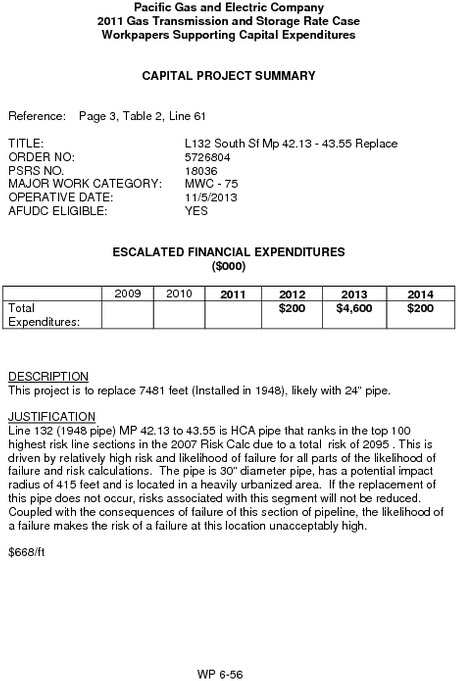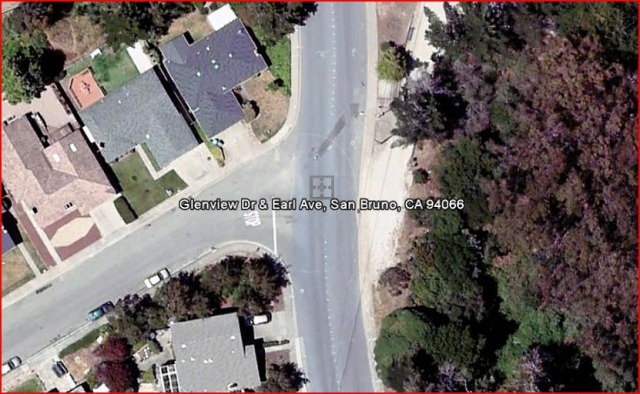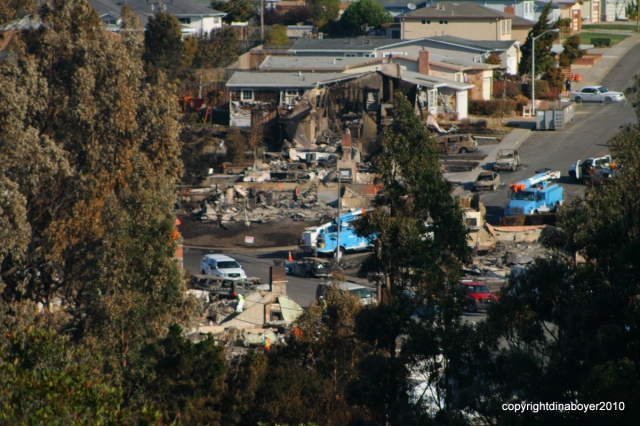From the Open-Publishing Calendar
From the Open-Publishing Newswire
Indybay Feature
Gas line explosion/PG&E caused?
The fire in San Bruno was caused by a gas line.
Residents said they smelled gas days leading up to this disaster.
The first picture is the fireball seen from Route 101 south of the San Bruno mountain.
Please check out my Youtube videos. lSan Bruno Fire part 1 uncut
San Bruno Fire part 2 uncut
San Bruno Fire part 3 uncut
The first picture is the fireball seen from Route 101 south of the San Bruno mountain.
Please check out my Youtube videos. lSan Bruno Fire part 1 uncut
San Bruno Fire part 2 uncut
San Bruno Fire part 3 uncut
Add Your Comments
Comments
(Hide Comments)
...and it certainly is interesting that PG & E was supposedly "looking into" funny smells due to resident reports days earlier. San Jose Merc reported this also I heard an citizen ask the Fire Chief on TV about that during a press conference. Fire Chief had no answer. Interestingly other corporate media is "staying away" from this aspect of the story. That's corporate media for you....
While Republicans cut taxes for the rich, our infrastructure shot to hell. The gas pipes in question were 60 years old. Several news sources now reporting that PG & E may be to blame.
Here's some background on an earlier natural gas pipeline explosion that was operated by El Paso corporation, they're behind the 680 mile long Ruby Pipeline from Wyoming to Malin, Oregon.
Not saying that this was the same cause as the recent PG&E natural gas pipeline explosion in San Bruno, though the science shows that corrosion of pipelines is to be expected after many years of operation.
To sum up the science jargon at the end of this article, corrosion is a result of microbial activity increasing the pH acidity within the pipeline, the greater pH then causing corrosive pitting and striations inside of the pipeline.
What pipeline operator corporations neglect to inform the public of is that over time this corrosive process occurs along the entire stretch of the pipeline. Since they do not wish to spend the money replacing the entire pipeline's length, they wait until the eventual rupture and resulting explosion and then replace the segments most effected. How many people or animals die from the explosion would be considered "collateral damage" to pipeline operating corporations.
"Corrosion of Natural Gas Pipeline
Rupture and Fire Near Carlsbad New Mexico August 19, 2000
Accident Synopsis
At 5:26 a.m., mountain daylight time, on Saturday, August 19, 2000, a 30-inch diameter natural gas transmission pipeline operated by El Paso Natural Gas Company (EPNG) ruptured adjacent to the Pecos River near Carlsbad, New Mexico. The released gas ignited and burned for 55 minutes. Twelve persons who were camping under a concrete-decked steel bridge that supported the pipeline across the river were killed and their three vehicles destroyed. Two nearby steel suspension bridges for gas pipelines crossing the river were extensively damaged. According to EPNGS property and other damages or losses totaled $998,296. (reference)
Accident Narrative
The EPNG pipeline system transported gas west from Texas and New Mexico to Arizona and California. A portion of the pipeline system crossed the Pecos River about 4 1/2 miles north of the Texas-New Mexico State line and 30 miles south of Carlsbad, New Mexico. About I mile west of the river crossing was the Pecos River compressor station, which received gas from four natural gas transmission pipelines 26-inch-diameter line 1100, 30-inch-diameter line 1103, 30-inch-diameter line 1110, and 16-inch-diameter line 3191. Three of these lines (1100, 1103, and 1110) ran parallel to Whitethorn Road (also known as Pipeline Road) from the Pecos River to the Pecos River compressor station. Lines 1103 and 1110 were supported at the river crossinga one-lane concrete-decked steel service bridge that was not open to the public.
This bridge, which had been built by EPNG in 1950, also supported a water pipeline and a gas gathering pipeline. EPNG which was at the time of the accident a subsidiary of El Paso Energy, owned and operated the water pipeline but not the gas gathering pipeline. Line 1100 was supported across the river on a pipeline suspension bridge approximately 70 feet northeast of the service bridge. Another EPNG pipeline, 16inch-diameter line 1000, was supported by a separate suspension bridge in this area, but this line had been removed from service and was filled with nitrogen at the time of the accident. The fourth pipeline, line 3191, ran from EPNG's South Carlsbad compressor station to the Pecos River compressor station.
Post-accident On-Site Inspection
The force of the rupture and the violent ignition of the escaping gas created a 51foot-wide crater about 113 feet along the pipe. A 49-foot section of the pipe was ejected from the crater in three pieces measuring approximately 3 feet, 20 feet, and 26 feet in length. (See figure 6.) The largest piece was found about 287 feet northwest of the crater in the direction of the suspension bridges. Investigators visually examined the pipeline that remained in the crater as well as the three ejected pieces. All three ejected pieces showed evidence of internal corrosion damage, but one of the pieces showed significantly more corrosion damage than the other two. Pits were visible on the inside surface of this piece, and at various locations, the pipe wall evidenced significant thinning. At one location, a through-wall perforation was visible. No significant corrosion damage was visible on the outside surfaces of the three pieces or on the two ends of the pipeline remaining in the crater. Pieces were cut from the ruptured pipeline segments and shipped to the Safety Board's Materials Laboratory in Washington, D.C., for further evaluation.
The drip" between block valve No. 6 and the rupture site was removed from the pipeline and visually examined. The drip was found to contain a blackish oily powdery grainy material. At the area of its heaviest concentration, about 13 feet from the drip opening, this material filled approximately 70 percent of the cross-sectional area of the drip. No significant material was observed in the area just underneath and several inches away from the siphon drain at the closed end of the drip. No significant internal corrosion was observed in the drip.
Injuries
All 12 persons who were camping on the east bank of the Pecos River were fatally injured in the accident. The causes of death were extensive thermal burns, carbon monoxide poisoning, and smoke inhalation.
Damages
Approximately 49 feet of the underground portion of line 1103 were ejected in three pieces from the crater created by the rupture. Two of the pieces of pipe were thrown 234 and 287 feet, respectively, from the northwest end of the crater toward the river. One of these pieces hit the cables that supported the pipeline suspension bridges across the river. The concrete anchor blocks for the cables, the cables themselves, and the two suspension bridge steel structures on the east side of the river were burned, as were the aboveground portions of the pipelines. The two pipelines that were being supported on the bridges (EPNG's 26-inch line 1100 and the out-of-service 16-inch line 1000) fell and came to rest on the ground on each side of the river, but neither leaked. The three vehicles and camping equipment on the east side of the river were destroyed, and vegetation along both riverbanks was burned. Based on photographs taken of the fire as it engulfed the suspension bridges, the height of the flame was calculated to be about 496 feet. EPNG, in its incident report to the Research and Special Programs Administration (RSPA), stated the cost of the accident was $998,296.
Internal Corrosion in Line 1103
Interconnecting pits were observed on the inside of the pipe in the ruptured area of line 1103. Typically, these pits showed the striations and undercutting features that are often associated with microbial corrosion. A pit profile showed that chloride concentration in the pits increased steadily from top to bottom. Increased chloride concentration can result from certain types of microbial activity. All four types of microbes (sulfate reducing, acid-producing, general aerobic, and anaerobic) were observed in samples collected from two pit areas in the piece of line 1103 where internal corrosion was discovered after the accident about 2,080 feet downstream of the rupture site. Though the individual contribution of various microbes in the corrosion process could not be estimated, the damage morphology and the corrosion product analyses data suggest that microbiological activity contributed to the corrosion process.
Dissolved O2 in an electrolyte could cause pitting by creating concentration cells. CO2 is soluble in water and will form carbonic acid, which is corrosive to carbon steel.
When dissolved in water, H2S forms a weak acid that could corrode carbon steel. In combination with dissolved O2, it could cause pitting. Though generally present in low concentrations, these potentially corrosive constituents were present in the gas that was being transported in line 1103. Also, upset conditions occasionally increased the concentrations of these constituents in the transported gas.
Chlorides were observed in all corrosion product/deposit samples. Anions, such as chloride, cause pitting and, typically, chloride concentration in a pit may be much higher than the chloride concentration outside the pit (bulk concentration).
Chemical analyses showed that the pH (6.7-6.8) of the liquid collected at the Pecos River compressor station plant inlet separator scrubber was more acidic than the pH (8.2) of the liquid collected at Keystone compressor station inlet scrubber. Also, the material collected at line 1100 and 1103 pig receivers (pH 6.2-6.3) and the inside material collected from a low spot on line 1103 west of the rupture (pH - 6.4) were more acidic than the material collected near the siphon drain area of the line 1103 drip (pH 8.9). The observed low pH in the samples could be a result of dissolved CO2, and/or H2S in the water, and/or intrusion of low-pH ground water into the gas supply. Typically, acidic (pH<7) water is more corrosive to carbon steel than basic water (pH>7).
Thus, water and contaminants such as chlorides, O2, CO2, and H2S all likely contributed to the observed corrosion damage. The Safety Board therefore concludes that the corrosion that was found in line 1103 at the rupture site was likely caused by a combination within the pipeline of microbes and such contaminants as moisture, chlorides, O2, CO2, and H2S."
read more here;
http://corrosion-doctors.org/Pipeline/Carlsbad-explosion.htm
Here's another article exposing myths of natural gas pipeline safety;
from Earth Alert;
"Natural gas pipeline safety is a myth. The U.S. Office of Pipeline Safety records hundreds of incidents involving gas pipelines each year. You can easily check this by visiting the pipeline statistics page of their website at http://www.ops.dot.gov.
But statistics don't tell the story of pain and loss that occur when an accident happens. Last week, I interviewed a registered nurse, one of the first responders to a natural gas explosion in August 2000 near Carlsbad, New Mexico. Millyn Dolphin, RN, was working for an air ambulance company. She was paged at seven a.m. that morning, and simply told there had been a gas explosion.
The explosion was discovered when El Paso Natural Gas Company employees noticed a 25 percent drop in pressure on the line. They sent out a crew and found flames shooting almost 500 feet into the air. The crew also found six people dead. They called for emergency response to air-evacuate the six other members of two families, including one-year-old twins, who had been camping by the river together. All but one of them would be dead before day's end. The remaining family member survived a month.
Millyn described how an EMT carried a fully conscious, crying five-year-old girl, burned over 79 percent of her body, through 300 yards of brush to reach an ambulance. He told Millyn he'd just seen a "little Hiroshima." In Millyn's care, the child survived a flight to Lubbock, but died while being flown to the Shriners Hospital burn unit in Galveston.
Millyn is now an activist, working to inform the public on pipeline safety issues so the child she cared for did not die in vain. She told me the gas pipeline was over-pressurized, causing the pipe to vibrate. The vibration caused the pipe to knock against a rock where a leak developed. The families' campfire turned the leaking gas into an inferno.
Millyn said these were prominent, well-known families in Artesia and Carlsbad, New Mexico, where the deaths shocked the community. "You could see it in their eyes for weeks," she said.
How does this pertain to you? Consider the devastation that accident caused in a remote area. What might the effect have been in a populated area?
Tuesday night there is a public hearing at the Oxnard Performing Arts Center on BHP Billiton's LNG Terminal Draft Environmental Impact Report, part of the application process to site one of two liquid natural gas (LNG) terminals off the shore of Oxnard. The project calls for a floating terminal moored 21 miles away from Oxnard and proposes to run a high volume gas pipe through the biologically sensitive areas of Ormond Beach, less than a mile from Pt. Hueneme's densely populated beach-front condominiums. Crystal Energy's project plan, the second one proposed for the area, is to be built on Platform Grace about 10 miles offshore. It calls for a high volume pressurized pipeline to run through Oxnard's residential neighborhoods, past churches and schools. Both proposed pipes would connect into the Southern California Gas network near Camarillo.
In an area as seismically active as coastal California, it's always just a matter of time before the next major earthquake causes gas pipelines to break. That is why one of the first things we're instructed to do in the event of an earthquake is to turn off our home's gas valve. And if you call the gas company telling them you suspect a leak, they'll send someone out immediately, day or night. That should tell you how potentially dangerous even a small amount of leaking natural gas can be.
If the plans for these LNG terminals are approved and implemented, the large pressurized pipes that bring in the gas may be a major disaster waiting for the right earthquake. The country's other LNG terminals are not in earthquake-prone areas. California has had incidents in the past involving gas pipeline ruptures during earthquakes and this equation brings a new set of variablesólarge pressurized natural gas pipelines crossing areas subject to liquefaction. Oxnard is being asked to be the guinea pig to test these variables. The companies building the pipelines will tell you they'll be safe, but there's no way they can absolutely guarantee it (see the pipeline safety website mentioned above).
If the safety of your community and its residents is something you care about, invest the time to go to the Oxnard Center for the Performing Arts Tuesday night to voice your concern. It beats the prospect of someday attending a mass funeral knowing you passed on the opportunity to try to prevent it.
For information on the Carlsbad explosion, visit;
http://www.corrosion-doctors.org/Pipeline/Carlsbad-explosion.htm.
* * *
by Janet Bridgers
Founder/Director
Earth Alert
"
article found here;
http://www.earthalert.org/articles/gas_pipeline.html
Not saying that this was the same cause as the recent PG&E natural gas pipeline explosion in San Bruno, though the science shows that corrosion of pipelines is to be expected after many years of operation.
To sum up the science jargon at the end of this article, corrosion is a result of microbial activity increasing the pH acidity within the pipeline, the greater pH then causing corrosive pitting and striations inside of the pipeline.
What pipeline operator corporations neglect to inform the public of is that over time this corrosive process occurs along the entire stretch of the pipeline. Since they do not wish to spend the money replacing the entire pipeline's length, they wait until the eventual rupture and resulting explosion and then replace the segments most effected. How many people or animals die from the explosion would be considered "collateral damage" to pipeline operating corporations.
"Corrosion of Natural Gas Pipeline
Rupture and Fire Near Carlsbad New Mexico August 19, 2000
Accident Synopsis
At 5:26 a.m., mountain daylight time, on Saturday, August 19, 2000, a 30-inch diameter natural gas transmission pipeline operated by El Paso Natural Gas Company (EPNG) ruptured adjacent to the Pecos River near Carlsbad, New Mexico. The released gas ignited and burned for 55 minutes. Twelve persons who were camping under a concrete-decked steel bridge that supported the pipeline across the river were killed and their three vehicles destroyed. Two nearby steel suspension bridges for gas pipelines crossing the river were extensively damaged. According to EPNGS property and other damages or losses totaled $998,296. (reference)
Accident Narrative
The EPNG pipeline system transported gas west from Texas and New Mexico to Arizona and California. A portion of the pipeline system crossed the Pecos River about 4 1/2 miles north of the Texas-New Mexico State line and 30 miles south of Carlsbad, New Mexico. About I mile west of the river crossing was the Pecos River compressor station, which received gas from four natural gas transmission pipelines 26-inch-diameter line 1100, 30-inch-diameter line 1103, 30-inch-diameter line 1110, and 16-inch-diameter line 3191. Three of these lines (1100, 1103, and 1110) ran parallel to Whitethorn Road (also known as Pipeline Road) from the Pecos River to the Pecos River compressor station. Lines 1103 and 1110 were supported at the river crossinga one-lane concrete-decked steel service bridge that was not open to the public.
This bridge, which had been built by EPNG in 1950, also supported a water pipeline and a gas gathering pipeline. EPNG which was at the time of the accident a subsidiary of El Paso Energy, owned and operated the water pipeline but not the gas gathering pipeline. Line 1100 was supported across the river on a pipeline suspension bridge approximately 70 feet northeast of the service bridge. Another EPNG pipeline, 16inch-diameter line 1000, was supported by a separate suspension bridge in this area, but this line had been removed from service and was filled with nitrogen at the time of the accident. The fourth pipeline, line 3191, ran from EPNG's South Carlsbad compressor station to the Pecos River compressor station.
Post-accident On-Site Inspection
The force of the rupture and the violent ignition of the escaping gas created a 51foot-wide crater about 113 feet along the pipe. A 49-foot section of the pipe was ejected from the crater in three pieces measuring approximately 3 feet, 20 feet, and 26 feet in length. (See figure 6.) The largest piece was found about 287 feet northwest of the crater in the direction of the suspension bridges. Investigators visually examined the pipeline that remained in the crater as well as the three ejected pieces. All three ejected pieces showed evidence of internal corrosion damage, but one of the pieces showed significantly more corrosion damage than the other two. Pits were visible on the inside surface of this piece, and at various locations, the pipe wall evidenced significant thinning. At one location, a through-wall perforation was visible. No significant corrosion damage was visible on the outside surfaces of the three pieces or on the two ends of the pipeline remaining in the crater. Pieces were cut from the ruptured pipeline segments and shipped to the Safety Board's Materials Laboratory in Washington, D.C., for further evaluation.
The drip" between block valve No. 6 and the rupture site was removed from the pipeline and visually examined. The drip was found to contain a blackish oily powdery grainy material. At the area of its heaviest concentration, about 13 feet from the drip opening, this material filled approximately 70 percent of the cross-sectional area of the drip. No significant material was observed in the area just underneath and several inches away from the siphon drain at the closed end of the drip. No significant internal corrosion was observed in the drip.
Injuries
All 12 persons who were camping on the east bank of the Pecos River were fatally injured in the accident. The causes of death were extensive thermal burns, carbon monoxide poisoning, and smoke inhalation.
Damages
Approximately 49 feet of the underground portion of line 1103 were ejected in three pieces from the crater created by the rupture. Two of the pieces of pipe were thrown 234 and 287 feet, respectively, from the northwest end of the crater toward the river. One of these pieces hit the cables that supported the pipeline suspension bridges across the river. The concrete anchor blocks for the cables, the cables themselves, and the two suspension bridge steel structures on the east side of the river were burned, as were the aboveground portions of the pipelines. The two pipelines that were being supported on the bridges (EPNG's 26-inch line 1100 and the out-of-service 16-inch line 1000) fell and came to rest on the ground on each side of the river, but neither leaked. The three vehicles and camping equipment on the east side of the river were destroyed, and vegetation along both riverbanks was burned. Based on photographs taken of the fire as it engulfed the suspension bridges, the height of the flame was calculated to be about 496 feet. EPNG, in its incident report to the Research and Special Programs Administration (RSPA), stated the cost of the accident was $998,296.
Internal Corrosion in Line 1103
Interconnecting pits were observed on the inside of the pipe in the ruptured area of line 1103. Typically, these pits showed the striations and undercutting features that are often associated with microbial corrosion. A pit profile showed that chloride concentration in the pits increased steadily from top to bottom. Increased chloride concentration can result from certain types of microbial activity. All four types of microbes (sulfate reducing, acid-producing, general aerobic, and anaerobic) were observed in samples collected from two pit areas in the piece of line 1103 where internal corrosion was discovered after the accident about 2,080 feet downstream of the rupture site. Though the individual contribution of various microbes in the corrosion process could not be estimated, the damage morphology and the corrosion product analyses data suggest that microbiological activity contributed to the corrosion process.
Dissolved O2 in an electrolyte could cause pitting by creating concentration cells. CO2 is soluble in water and will form carbonic acid, which is corrosive to carbon steel.
When dissolved in water, H2S forms a weak acid that could corrode carbon steel. In combination with dissolved O2, it could cause pitting. Though generally present in low concentrations, these potentially corrosive constituents were present in the gas that was being transported in line 1103. Also, upset conditions occasionally increased the concentrations of these constituents in the transported gas.
Chlorides were observed in all corrosion product/deposit samples. Anions, such as chloride, cause pitting and, typically, chloride concentration in a pit may be much higher than the chloride concentration outside the pit (bulk concentration).
Chemical analyses showed that the pH (6.7-6.8) of the liquid collected at the Pecos River compressor station plant inlet separator scrubber was more acidic than the pH (8.2) of the liquid collected at Keystone compressor station inlet scrubber. Also, the material collected at line 1100 and 1103 pig receivers (pH 6.2-6.3) and the inside material collected from a low spot on line 1103 west of the rupture (pH - 6.4) were more acidic than the material collected near the siphon drain area of the line 1103 drip (pH 8.9). The observed low pH in the samples could be a result of dissolved CO2, and/or H2S in the water, and/or intrusion of low-pH ground water into the gas supply. Typically, acidic (pH<7) water is more corrosive to carbon steel than basic water (pH>7).
Thus, water and contaminants such as chlorides, O2, CO2, and H2S all likely contributed to the observed corrosion damage. The Safety Board therefore concludes that the corrosion that was found in line 1103 at the rupture site was likely caused by a combination within the pipeline of microbes and such contaminants as moisture, chlorides, O2, CO2, and H2S."
read more here;
http://corrosion-doctors.org/Pipeline/Carlsbad-explosion.htm
Here's another article exposing myths of natural gas pipeline safety;
from Earth Alert;
"Natural gas pipeline safety is a myth. The U.S. Office of Pipeline Safety records hundreds of incidents involving gas pipelines each year. You can easily check this by visiting the pipeline statistics page of their website at http://www.ops.dot.gov.
But statistics don't tell the story of pain and loss that occur when an accident happens. Last week, I interviewed a registered nurse, one of the first responders to a natural gas explosion in August 2000 near Carlsbad, New Mexico. Millyn Dolphin, RN, was working for an air ambulance company. She was paged at seven a.m. that morning, and simply told there had been a gas explosion.
The explosion was discovered when El Paso Natural Gas Company employees noticed a 25 percent drop in pressure on the line. They sent out a crew and found flames shooting almost 500 feet into the air. The crew also found six people dead. They called for emergency response to air-evacuate the six other members of two families, including one-year-old twins, who had been camping by the river together. All but one of them would be dead before day's end. The remaining family member survived a month.
Millyn described how an EMT carried a fully conscious, crying five-year-old girl, burned over 79 percent of her body, through 300 yards of brush to reach an ambulance. He told Millyn he'd just seen a "little Hiroshima." In Millyn's care, the child survived a flight to Lubbock, but died while being flown to the Shriners Hospital burn unit in Galveston.
Millyn is now an activist, working to inform the public on pipeline safety issues so the child she cared for did not die in vain. She told me the gas pipeline was over-pressurized, causing the pipe to vibrate. The vibration caused the pipe to knock against a rock where a leak developed. The families' campfire turned the leaking gas into an inferno.
Millyn said these were prominent, well-known families in Artesia and Carlsbad, New Mexico, where the deaths shocked the community. "You could see it in their eyes for weeks," she said.
How does this pertain to you? Consider the devastation that accident caused in a remote area. What might the effect have been in a populated area?
Tuesday night there is a public hearing at the Oxnard Performing Arts Center on BHP Billiton's LNG Terminal Draft Environmental Impact Report, part of the application process to site one of two liquid natural gas (LNG) terminals off the shore of Oxnard. The project calls for a floating terminal moored 21 miles away from Oxnard and proposes to run a high volume gas pipe through the biologically sensitive areas of Ormond Beach, less than a mile from Pt. Hueneme's densely populated beach-front condominiums. Crystal Energy's project plan, the second one proposed for the area, is to be built on Platform Grace about 10 miles offshore. It calls for a high volume pressurized pipeline to run through Oxnard's residential neighborhoods, past churches and schools. Both proposed pipes would connect into the Southern California Gas network near Camarillo.
In an area as seismically active as coastal California, it's always just a matter of time before the next major earthquake causes gas pipelines to break. That is why one of the first things we're instructed to do in the event of an earthquake is to turn off our home's gas valve. And if you call the gas company telling them you suspect a leak, they'll send someone out immediately, day or night. That should tell you how potentially dangerous even a small amount of leaking natural gas can be.
If the plans for these LNG terminals are approved and implemented, the large pressurized pipes that bring in the gas may be a major disaster waiting for the right earthquake. The country's other LNG terminals are not in earthquake-prone areas. California has had incidents in the past involving gas pipeline ruptures during earthquakes and this equation brings a new set of variablesólarge pressurized natural gas pipelines crossing areas subject to liquefaction. Oxnard is being asked to be the guinea pig to test these variables. The companies building the pipelines will tell you they'll be safe, but there's no way they can absolutely guarantee it (see the pipeline safety website mentioned above).
If the safety of your community and its residents is something you care about, invest the time to go to the Oxnard Center for the Performing Arts Tuesday night to voice your concern. It beats the prospect of someday attending a mass funeral knowing you passed on the opportunity to try to prevent it.
For information on the Carlsbad explosion, visit;
http://www.corrosion-doctors.org/Pipeline/Carlsbad-explosion.htm.
* * *
by Janet Bridgers
Founder/Director
Earth Alert
"
article found here;
http://www.earthalert.org/articles/gas_pipeline.html
The private profit system is literally killing us and the planet, whether it be with old explosing gas pipelines that could have and should have been replaced sometime ago, or oil disasters in the Gulf of Mexico because we have a government that promotes the private profit system and allows offshore oil drilling or fires in Detroit caused by a bad power grid or collapsing mines due to lack of mine inspection and enforcement of safety regulations or constant food poisoning disasters, the latest being egg recalls due to salmonella from eggs that were from factory farms that had 8 foot tall excrement piles in the chicken houses and much more.
We have had many efforts to abolish PG&E and establish public power. After all, Palo Alto, Sacramento and Los Angeles have public power. It is insane to have our utilities in the hands of private profit companies whose primary concern is maximization of profit, which is always contrary to public safety. The accountability system, namely the California Public Utilities Commission, is weak, and is only now calling for statewide gasline inspections because they are faced with certain lawsuits as both PG&E and the State of California are liable for this horrifying disaster that could happen anywhere as our infrastructure is declining rapidly because the private profit system puts private greed before human need, and labor is weak and not fighting back for all our needs. Obviously, all employment should be public and there should be no private profit system, which is only possible with a strong labor movement.
Here is one assessment:
From: Gas line explosion in California kills four, injures dozens
By Kevin Kearney, 11 September 2010
http://www.wsws.org/articles/2010/sep2010/brun-s11.shtml
Home » World News PrintLeafletFeedbackShare »
FacebookTwitterDiggRedditDeliciousE-Mail.Gas line explosion in California kills four, injures dozens
By Kevin Kearney
11 September 2010
Four people were killed, 52 injured, and dozens of homes were destroyed when a gas line exploded in the San Francisco suburb of San Bruno Thursday evening.
The sudden blast occurred around 6:24 pm, leaving a crater measuring 30 feet in diameter and 15 feet deep, according to one estimate. The explosion created a fire zone of approximately 15 to 20 acres, engulfing much of the neighborhood in flames throughout the evening and the following morning. By Friday afternoon reports indicated the blaze was 75 percent contained.
Reports indicate 35 to 50 houses were completely destroyed, and several more were severely damaged. With some of the injured in critical condition, the death toll from the blast could rise. By Friday afternoon, city officials were still unable to account for all residents in the area. More than 100 had been evacuated to shelters.
At least four firefighters sustained injuries in the struggle to contain the fire.
San Bruno lies very close to the San Francisco International Airport, about 12 miles south of downtown San Francisco, extending from the lowlands of the bay into the foothills of the Santa Cruz mountains. The foothills open up to the offshore winds of the Pacific Ocean, which are channeled through San Bruno into the bay. This worked to exacerbate the fire. Until it is completely extinguished, the danger of further destruction will remain.
The blast was so strong it could be heard and felt miles away. When reports of a fireball rising 80-100 feet in the air began to pour into call centers, officials surveyed the site and initially believed an errant plane from the airport had crashed into the city—a testament to the scale of the explosion.
Six different fire departments quickly provided over 200 firemen to battle the blaze through the night, but their efforts were limited by the intensity of the heat, which reportedly melted tail lights on cars parked blocks away. “The radiant heat from the actual gas and the fireball was making it so that they couldn’t even attack the homes that were on fire,” said news photographer Bryan Carmody, who arrived shortly after the blast.
Although the explosion originated in the main gas line, the ensuing fire developed along several lesser gas pipes connecting to neighborhood homes. An overhead view of the scene revealed several large self-sustaining gas fires throughout the zone. San Bruno Fire Chief Dennis Haag explained in a news conference on Friday that each gas line had to be shut down. Visibly shaken, he described areas the fire had ravaged as a “moonscape.”
Complicating the effort to combat the fire, water pressure in the area was low because the fire destroyed a critical water main, compelling firefighters to truck in water.
Appearing for Governor Arnold Schwarzenegger, who is currently out of state, Lieutenant Governor Abel Maldonado declared a state of emergency. The National Transportation Safety Board has launched an investigation.
The ruptured natural gas line was owned, operated and maintained by Pacific Gas and Electric Corp. (PG&E), one of the largest natural gas and electric utilities in the United States. The company provides gas and electricity to approximately 15 million people throughout a 70,000-square-mile area in northern California reaching from Eureka in the north to Bakersfield in the south, and from the Pacific Ocean in the west to the Sierra Nevada in the east. This includes 42,141 miles of natural gas distribution pipelines and 4.3 million natural gas customers.
Since the blast, the company has maintained a very careful public relations posture, saying and publishing as little as possible about what caused such a horrible accident.
However, area residents say they had complained to PG&E of a possible gas leak for weeks, but that the utility had apparently done nothing about it, according to several media accounts.
Neighborhood resident Tim Guiterrez told reporters he called PG&E about a distinct smell of gas that had been present for three weeks. “Every day after work, I would smell the heavy smell coming from the gutter and sewer,” he said. According to Guiterrez, a company representative arrived in the neighborhood a week prior to the explosion and told people to shut their garage doors and stay inside as they investigated.
Within hours of the explosion, PG&E President Chris Johns issued a terse e-mail statement to the press declaring “if it is ultimately determined that we were responsible for the cause of the incident, we will take accountability.” The following morning, as houses still smoldered and families scrambled to find their loved ones, Johns held a brief press conference. Referring to revelations of the prior complaints of a gas leak, Johns said, “Right now, we haven’t got confirmation about that … we will report back as soon as we know something.”
While the cause of the ruptured gas line and explosion is not yet clear, over the last year PG&E has been carrying out an intensive cost-cutting campaign, reducing its workforce by installing “smart meters” in homes throughout Northern California.
Unlike the old meters which required regular inspection by PG&E technicians, the smart meters report household energy consumption directly to the company’s billing office, slashing the number of technicians on the ground that previously monitored gas and electricity issues in California neighborhoods.
There is also the question of the integrity of the gas pipeline itself. How often was it inspected? Did federal or state regulators in any way enforce maintenance and inspections?
The San Bruno explosion is the latest in a series of disasters—the recent fires in Detroit caused by a decrepit power grid, the BP Deepwater Horizon blowout in the Gulf of Mexico, the Upper Big Branch mine disaster in West Virginia—that indicate the advanced decay of US infrastructure, the complete failure of “deregulation” to protect the population, and the reckless greed of the corporate elite.
The United States is a highly developed mass society with a complex infrastructure that can only be maintained by a significant expenditure of resources. This has become completely incompatible with capitalism. In this sense, the explosion of the San Bruno neighborhood is not an isolated event. It is of a piece with a host of festering and extremely dangerous infrastructure problems throughout the nation which have been exacerbated by the economic crisis.
A neighborhood’s transformation to rubble and ash in a mere 24 hours stands as a stark reminder: the maintenance and delivery of energy and every other socially necessary service has become far too important and potentially dangerous to be left in the hands of profit-mad corporations.
We have had many efforts to abolish PG&E and establish public power. After all, Palo Alto, Sacramento and Los Angeles have public power. It is insane to have our utilities in the hands of private profit companies whose primary concern is maximization of profit, which is always contrary to public safety. The accountability system, namely the California Public Utilities Commission, is weak, and is only now calling for statewide gasline inspections because they are faced with certain lawsuits as both PG&E and the State of California are liable for this horrifying disaster that could happen anywhere as our infrastructure is declining rapidly because the private profit system puts private greed before human need, and labor is weak and not fighting back for all our needs. Obviously, all employment should be public and there should be no private profit system, which is only possible with a strong labor movement.
Here is one assessment:
From: Gas line explosion in California kills four, injures dozens
By Kevin Kearney, 11 September 2010
http://www.wsws.org/articles/2010/sep2010/brun-s11.shtml
Home » World News PrintLeafletFeedbackShare »
FacebookTwitterDiggRedditDeliciousE-Mail.Gas line explosion in California kills four, injures dozens
By Kevin Kearney
11 September 2010
Four people were killed, 52 injured, and dozens of homes were destroyed when a gas line exploded in the San Francisco suburb of San Bruno Thursday evening.
The sudden blast occurred around 6:24 pm, leaving a crater measuring 30 feet in diameter and 15 feet deep, according to one estimate. The explosion created a fire zone of approximately 15 to 20 acres, engulfing much of the neighborhood in flames throughout the evening and the following morning. By Friday afternoon reports indicated the blaze was 75 percent contained.
Reports indicate 35 to 50 houses were completely destroyed, and several more were severely damaged. With some of the injured in critical condition, the death toll from the blast could rise. By Friday afternoon, city officials were still unable to account for all residents in the area. More than 100 had been evacuated to shelters.
At least four firefighters sustained injuries in the struggle to contain the fire.
San Bruno lies very close to the San Francisco International Airport, about 12 miles south of downtown San Francisco, extending from the lowlands of the bay into the foothills of the Santa Cruz mountains. The foothills open up to the offshore winds of the Pacific Ocean, which are channeled through San Bruno into the bay. This worked to exacerbate the fire. Until it is completely extinguished, the danger of further destruction will remain.
The blast was so strong it could be heard and felt miles away. When reports of a fireball rising 80-100 feet in the air began to pour into call centers, officials surveyed the site and initially believed an errant plane from the airport had crashed into the city—a testament to the scale of the explosion.
Six different fire departments quickly provided over 200 firemen to battle the blaze through the night, but their efforts were limited by the intensity of the heat, which reportedly melted tail lights on cars parked blocks away. “The radiant heat from the actual gas and the fireball was making it so that they couldn’t even attack the homes that were on fire,” said news photographer Bryan Carmody, who arrived shortly after the blast.
Although the explosion originated in the main gas line, the ensuing fire developed along several lesser gas pipes connecting to neighborhood homes. An overhead view of the scene revealed several large self-sustaining gas fires throughout the zone. San Bruno Fire Chief Dennis Haag explained in a news conference on Friday that each gas line had to be shut down. Visibly shaken, he described areas the fire had ravaged as a “moonscape.”
Complicating the effort to combat the fire, water pressure in the area was low because the fire destroyed a critical water main, compelling firefighters to truck in water.
Appearing for Governor Arnold Schwarzenegger, who is currently out of state, Lieutenant Governor Abel Maldonado declared a state of emergency. The National Transportation Safety Board has launched an investigation.
The ruptured natural gas line was owned, operated and maintained by Pacific Gas and Electric Corp. (PG&E), one of the largest natural gas and electric utilities in the United States. The company provides gas and electricity to approximately 15 million people throughout a 70,000-square-mile area in northern California reaching from Eureka in the north to Bakersfield in the south, and from the Pacific Ocean in the west to the Sierra Nevada in the east. This includes 42,141 miles of natural gas distribution pipelines and 4.3 million natural gas customers.
Since the blast, the company has maintained a very careful public relations posture, saying and publishing as little as possible about what caused such a horrible accident.
However, area residents say they had complained to PG&E of a possible gas leak for weeks, but that the utility had apparently done nothing about it, according to several media accounts.
Neighborhood resident Tim Guiterrez told reporters he called PG&E about a distinct smell of gas that had been present for three weeks. “Every day after work, I would smell the heavy smell coming from the gutter and sewer,” he said. According to Guiterrez, a company representative arrived in the neighborhood a week prior to the explosion and told people to shut their garage doors and stay inside as they investigated.
Within hours of the explosion, PG&E President Chris Johns issued a terse e-mail statement to the press declaring “if it is ultimately determined that we were responsible for the cause of the incident, we will take accountability.” The following morning, as houses still smoldered and families scrambled to find their loved ones, Johns held a brief press conference. Referring to revelations of the prior complaints of a gas leak, Johns said, “Right now, we haven’t got confirmation about that … we will report back as soon as we know something.”
While the cause of the ruptured gas line and explosion is not yet clear, over the last year PG&E has been carrying out an intensive cost-cutting campaign, reducing its workforce by installing “smart meters” in homes throughout Northern California.
Unlike the old meters which required regular inspection by PG&E technicians, the smart meters report household energy consumption directly to the company’s billing office, slashing the number of technicians on the ground that previously monitored gas and electricity issues in California neighborhoods.
There is also the question of the integrity of the gas pipeline itself. How often was it inspected? Did federal or state regulators in any way enforce maintenance and inspections?
The San Bruno explosion is the latest in a series of disasters—the recent fires in Detroit caused by a decrepit power grid, the BP Deepwater Horizon blowout in the Gulf of Mexico, the Upper Big Branch mine disaster in West Virginia—that indicate the advanced decay of US infrastructure, the complete failure of “deregulation” to protect the population, and the reckless greed of the corporate elite.
The United States is a highly developed mass society with a complex infrastructure that can only be maintained by a significant expenditure of resources. This has become completely incompatible with capitalism. In this sense, the explosion of the San Bruno neighborhood is not an isolated event. It is of a piece with a host of festering and extremely dangerous infrastructure problems throughout the nation which have been exacerbated by the economic crisis.
A neighborhood’s transformation to rubble and ash in a mere 24 hours stands as a stark reminder: the maintenance and delivery of energy and every other socially necessary service has become far too important and potentially dangerous to be left in the hands of profit-mad corporations.
For more information:
http://www.wsws.org/articles/2010/sep2010/...
The picture attached shows the intersection where the blast occured. There is a black patch of cement and a white circle drawn around the exact spot where the explosion took place.
I am attaching just one of many pics that shows the destruction a ruptured gas line can cause.
We are 100% volunteer and depend on your participation to sustain our efforts!
Get Involved
If you'd like to help with maintaining or developing the website, contact us.
Publish
Publish your stories and upcoming events on Indybay.
Topics
More
Search Indybay's Archives
Advanced Search
►
▼
IMC Network


